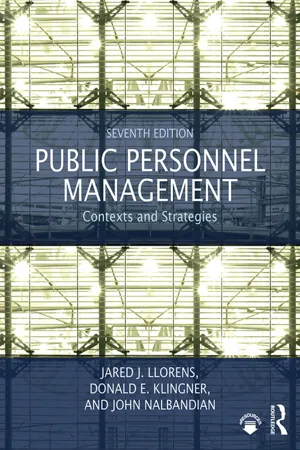
Public Personnel Management
Contexts and Strategies
- 362 pages
- English
- ePUB (mobile friendly)
- Available on iOS & Android
Public Personnel Management
Contexts and Strategies
About this book
Now in a thoroughly revised 7th edition, Public Personnel Management focuses on the critical issues and common processes in the management of public sector personnel. In keeping with prior editions, the text centers on the core processes within public human resource management: strategic workforce planning, effective recruitment and retention, workforce development, and employee relations. Designed to further address the ways in which expectations for human resource managers have changed and developed in recent years, the 7th edition includes several new features and improvements:
- Substantially restructured, updated, and additional case studies and student exercises.
- Coverage of how the field of Public HRM has been influenced by the two most recent national recessions, economic downturns at the state and local level, privatization and contracting trends at all levels of government, the growing presence of millennial employees in the workplace, issues surrounding social media use within the workplace, the evolving goals of social equity and diversity, and the shifting role and influence of labor unions.
- Discussions of how the growth in information technology capabilities has influenced the major processes within HRM, from workforce analysis through big data analytics to the explosion in automated recruitment, assessment, and instructional technologies.
- For the first time, the text includes an online Instructor's Manual, PowerPoint slides, discussion questions, and suggestions for further reading to make it even easier to assign and use this classic text in the classroom.
Providing the most up-to-date and thorough overview of the history and practice of public human resource management for both undergraduate and graduate students, Public Personnel Management, 7e remains the beloved text it ever was, ideal for introductory courses in Public Personnel Management, Public Human Resource Management, and Nonprofit Personnel Management.
Frequently asked questions
- Essential is ideal for learners and professionals who enjoy exploring a wide range of subjects. Access the Essential Library with 800,000+ trusted titles and best-sellers across business, personal growth, and the humanities. Includes unlimited reading time and Standard Read Aloud voice.
- Complete: Perfect for advanced learners and researchers needing full, unrestricted access. Unlock 1.4M+ books across hundreds of subjects, including academic and specialized titles. The Complete Plan also includes advanced features like Premium Read Aloud and Research Assistant.
Please note we cannot support devices running on iOS 13 and Android 7 or earlier. Learn more about using the app.
Information
Part One
Chapter 1
- Define the functions needed to manage human resources.
- Explain why public jobs are scarce resources.
- Describe the four traditional values that underlie the conflict over public jobs.
- Discuss some consequences of these emergent HRM practices on state civil service reform efforts and traditional values.
- Describe the history of public personnel management in the United States as one of conflict and compromise among competing personnel systems and values.
- Explore the relationship between economic development and governance capacity, and propose an agenda for strengthening merit systems in transitional or fragile states.
| Function | Purpose |
| | |
| Planning | Budget preparation, workforce planning; performance management, job analysis, and pay and benefits |
| Acquisition | Recruitment and selection of employees |
| Development | Training, evaluating, and leading employees to increase their willingness and ability to perform well |
| Sanction | Maintaining expectations and obligations that employees and the employer have toward one another through discipline, health and safety, and employee rights |
Human Resource Management Functions
Public Jobs as Scarce Resources
The Four Traditional Values
- Political responsiveness and representation —an appointment process that considers personal loyalty and political support as indicators of merit.
- Efficiency —making staffing decisions based on applicants’ and employees’ abilities and performance.
- Employee rights —protecting employees from political interference or arbitrary treatment that may threaten their job security or interfere with their job performance.
- Social equity —adequately representing all groups in the workforce and managing this diverse workforce to maintain productivity and a positive organizational culture.
The Four Traditional Public HRM Systems: Patronage, Civil Service, Collective Bargaining, and Equal Employment Opportunity
Political Patronage
Civil Service (Merit) Systems
| 1. | Recruitment should be from qualified individuals from appropriate sources in an endeavor to achieve a workforce from all segments of society, and selection and advanceme... |
Table of contents
- Cover
- Title
- Copyright
- CONTENTS
- Part I Introduction
- Part II Planning
- Part III Acquisition
- Part IV Development
- Part V Sanctions
- Index